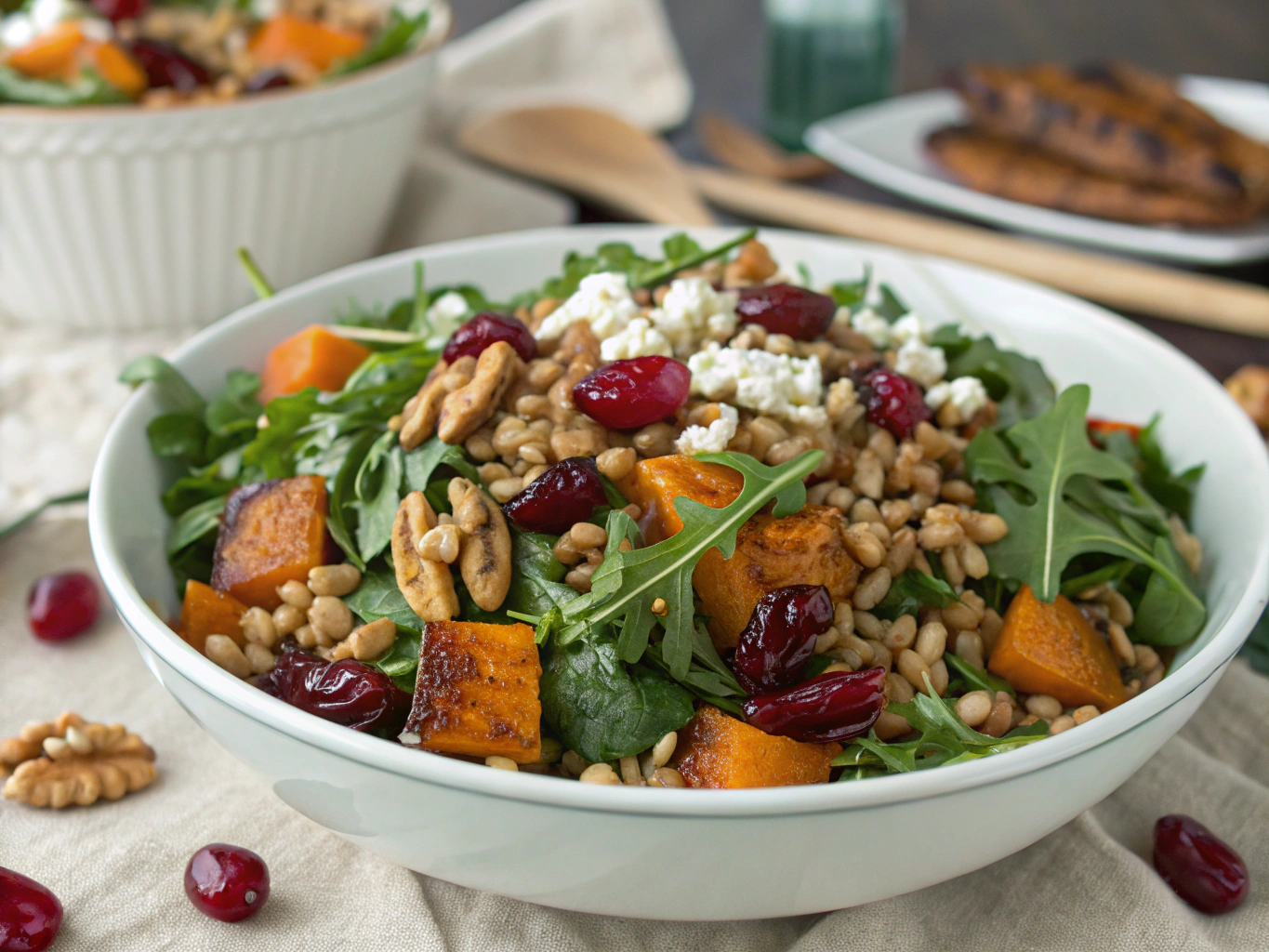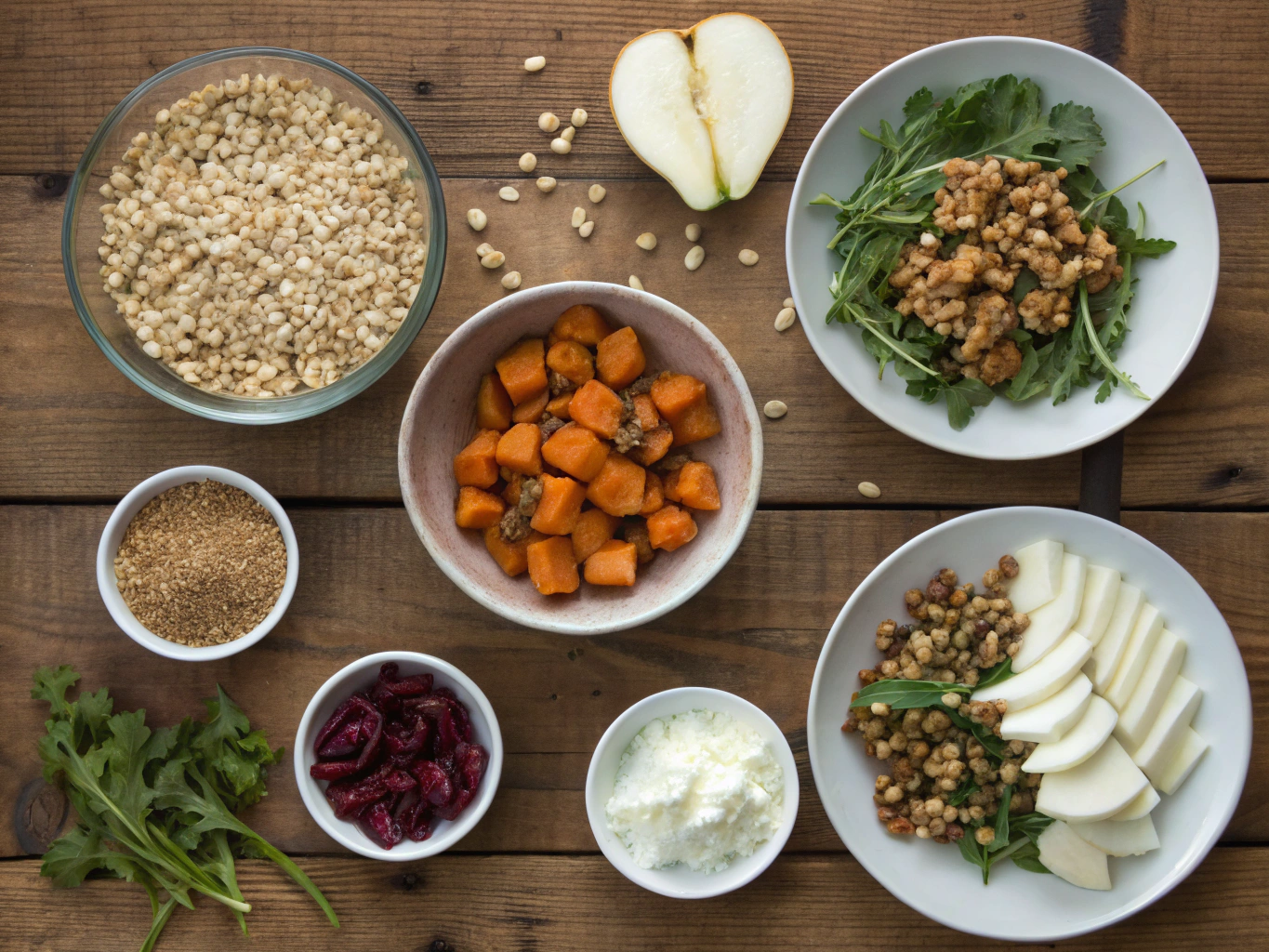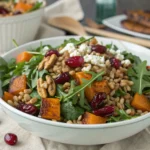
Table of Contents
Winter can feel like a season of hibernation, especially when it comes to food. But that’s exactly why I love making dishes like winter farro salad—bright, bold, and full of earthy flavor. This isn’t your average leafy bowl. It’s a warm, nourishing mix of ancient grains, seasonal veggies, and zippy dressings that bring comfort without weighing you down.
In this article, we’ll dive into what makes winter farro salad a seasonal staple, how to bring it to life in your kitchen, why farro deserves its top-shelf grain status, and how you can prep this recipe for busy weeks ahead. If you’re familiar with my farro sweet potato salad or cabbage farro soup, you’ll recognize the same cozy energy packed into this dish—with a winter twist.
The Inspiration Behind My Favorite Winter Farro Salad
Where It All Began
I’ll never forget the first time I made winter farro salad. It was a rainy Sunday in Portland, and I had just finished hauling a basket of beets, kale, and squash from the local farmer’s market. Inspired by the season, I grabbed a bag of farro from my pantry—a hasty impulse purchase I made after reading about fiber-rich grains—and set to work.
That afternoon, the kitchen smelled like roasted garlic and earthy root vegetables. I tossed them with nutty farro, drizzled on a maple-mustard dressing, and took my first bite. It was everything I didn’t know I needed: warm, textured, comforting. And just like that, winter farro salad became a cold-weather tradition in my kitchen.
Since then, I’ve experimented often. I drew flavor cues from my quinoa farro salad and even tested a warmer approach inspired by Trader Joe’s farro recipes. But the heart of this dish is the season—winter’s unique palate of smoky, sweet, and hearty flavors.
Why Winter Farro Salad Wins This Season
Winter vegetables are incredibly underrated. Think roasted brussels sprouts, caramelized squash, ruby-red pomegranate seeds, and crispy shallots. Combined with farro, a slightly chewy grain that eases digestion and boosts satiety, you’ve got a power salad fit for lunch or dinner.
This dish isn’t just trendy; it’s versatile. Hot or room temp, hearty or refreshing, farro transforms typical salad concepts into something unforgettable. It holds up well when dressed, stores like a dream, and pairs with sweet or savory ingredients.
When I think about what gets me through winter—beyond thermals and tea—it’s making food that feels nourishing. Winter farro salad is that for me.
How to Make a Winter Farro Salad That Actually Excites You
Ingredients That Warm You From the Inside Out

Let’s build a base of bold winter flavor. Here’s what you’ll need:
| Ingredient | Notes / Substitutions |
|---|---|
| 1 cup pearled farro | Sub with barley or quinoa if needed |
| 1 cup cubed roasted butternut squash | Use sweet potato as an alternative |
| ½ cup pomegranate seeds | Adds color and a zesty crunch |
| ½ red onion, thinly sliced | Shallots work great too |
| 2 cups chopped lacinato kale | Massage with lemon for softness |
| ¼ cup toasted walnuts | Pumpkin seeds for nut-free option |
| For dressing: olive oil, Dijon mustard, maple syrup, balsamic vinegar | Balance of tangy, sweet, and rich |
Cooking Timeline: Start to Finish
Making this winter farro salad is quicker than it looks. From prep to plate, you’ll need around 40 minutes—about 20% less than most warm grain salads.
- Prep Time: 10 minutes (while oven preheats)
- Roast Time: 20 minutes for squash and onion
- Farro Cooking Time: 20–25 minutes
- Assembly: 5 minutes
Pro tip: Cook your farro and roast your veggies at the same time to streamline things.
Step-by-Step Method: Let’s Build it Together
- Rinse the farro under cold water. In a pot, bring 3 cups of salted water to boil, add farro, then reduce heat and simmer uncovered for 20–25 minutes until tender but chewy. Drain excess water.
- While the farro cooks, preheat your oven to 400°F. Toss squash and sliced onion with olive oil, salt, and black pepper. Spread on a baking sheet and roast for 20 minutes or until caramelized.
- In a large bowl, massage chopped kale with a little lemon juice and olive oil for 30 seconds, softening the leaves.
- Prepare the dressing: whisk 3 tbsp olive oil, 1 tbsp balsamic vinegar, 1 tsp Dijon mustard, and 2 tsp maple syrup until emulsified.
- Once everything’s cooked, combine farro, roasted veggies, massaged kale, pomegranate seeds, walnuts, and dressing. Toss thoroughly.
- Let the salad sit for 5–10 minutes before serving—this helps the flavors blend beautifully.
For extra inspiration, check out how savory grains show up in my lentil farro soup.
Unlocking the Power of Farro in Your Winter Kitchen
What Makes Farro Perfect for Winter Recipes?
Farro is more than an ancient grain—it’s a cold-weather hero. It has a nutty flavor that pairs naturally with roasted vegetables and metallic greens like kale or chard. Heartier than rice and not as heavy as barley, it holds up well in dishes and doesn’t get soggy—perfect for meal prep.
Packed with fiber, protein, magnesium, and antioxidants, farro delivers long‑lasting energy while supporting digestion. If you’re curious about the science behind farro’s role in a balanced diet, the article “How Farro Benefits Digestion, Heart Health, and More” by Verywell Health explores how farro’s fiber, resistant starch, and antioxidants help regulate blood sugar, improve digestion, and reduce inflammation. You can read more about it here: How Farro Benefits Digestion, Heart Health, and More.
Its versatility shines in everything from my summer farro salad to rustic soups—or even as a base for a more Mediterranean spin like this farro caprese salad.
Texture, Taste, and Hearty Satisfaction
Unlike quinoa or couscous, farro has a chewier texture that adds satisfying bite. In a salad, that means every forkful delivers contrast—soft squash, crunchy kale, juicy pomegranate.
And the flavor? It’s mellow yet earthy, the kind of palate you appreciate more with each bite. In winter, when taste buds crave umami and comfort, farro steps up.
Drizzle with maple-balsamic, fold in citrus zest, top with roasted chickpeas—you can adapt the flavor profile endlessly.
Bringing It All Together: Variations, Prep & Storage Tips
Can You Make Farro Salad for Meal Prep?
Absolutely. This winter farro salad is even better on Day 2 when the flavors have melded together. Store it in a sealed glass container in the fridge for up to four days.
For weekly planning:
- Make dressings in advanced mason jars.
- Pre-cook farro and freeze in batches.
- Keep roasted veggies separate if you prefer added crunch on each serving day.
Adaptations For Every Craving
Want to make it Mediterranean-inspired? Sub out walnuts for kalamata olives and toss in marinated artichokes.
Craving something smoky? Add chipotle-seasoned sweet potatoes or a sprinkle of smoked paprika on top for a southwest twist.
Not a fan of kale? Use arugula or even baby spinach, but add it after the salad cools to avoid wilting.
Just like my other favorites in the Olives + Mediterranean collection, this dish is endlessly tweakable while still plant-forward and flavor-rich.
FAQs: Winter Farro Salad Questions, Answered
What ingredients are common in a winter farro salad?
The base typically includes cooked farro, roasted vegetables like squash or Brussels sprouts, hearty greens like kale or chard, nuts or seeds for crunch, and a seasonal dressing (often citrusy or warm spice-infused).
Is farro salad served warm in winter?
Yes! Winter farro salad is often served warm or slightly warm, making it a comforting yet wholesome option on cold days. It can also be enjoyed at room temperature.
Can you make a farro salad ahead for meal prep?
Definitely. Winter farro salad is a top choice for meal prep thanks to farro’s sturdy texture and the use of hardy ingredients that hold up well for days.
What makes farro a good grain for winter salads?
Its chewy texture, nutty richness, and nutritional profile make farro ideal. It complements roasted winter ingredients beautifully and doesn’t get mushy after sitting with dressing.
Why Winter Farro Salad Should Be Your Go-To Grain Bowl
Winter farro salad is like a warm hug in a bowl—without sacrificing texture or bold flavors. From the first chewy bite of farro to the brightness of pomegranate, every element balances satisfaction with nutrition. This dish is more than a recipe. It’s a reminder that winter food can be exciting, vibrant, and full of intention. Whether you’re building out comforting meals for the week or hosting a holiday table, this salad delivers.
Try it once, and don’t be surprised if it makes it into your seasonal rotation—as it did for me over a rainy Portland winter with a bag of farro and a spark of creativity.
Print
Winter Farro Salad: A Hearty, Plant-Powered Dish for Chilly Days
- Total Time: 40 minutes
- Yield: 4 servings 1x
- Diet: Vegetarian
Description
Winter farro salad is a warm, nourishing mix of ancient grains, seasonal veggies, and zippy dressings. It’s a comforting yet vibrant dish that celebrates winter’s unique flavors—perfect for both cozy nights and meal prep.
Ingredients
1 cup pearled farro
1 cup cubed roasted butternut squash
1/2 cup pomegranate seeds
1/2 red onion, thinly sliced
2 cups chopped lacinato kale
1/4 cup toasted walnuts
3 tbsp olive oil
1 tbsp balsamic vinegar
1 tsp Dijon mustard
2 tsp maple syrup
Salt and black pepper to taste
Lemon juice (for massaging kale)
Instructions
1. Rinse the farro and bring 3 cups of salted water to boil. Add farro, reduce heat, and simmer for 20–25 minutes. Drain.
2. Preheat oven to 400°F. Toss squash and onion with olive oil, salt, and pepper. Roast for 20 minutes.
3. Massage chopped kale with lemon juice and a bit of olive oil until softened.
4. Whisk olive oil, balsamic vinegar, Dijon mustard, and maple syrup to make dressing.
5. In a large bowl, combine cooked farro, roasted vegetables, kale, pomegranate seeds, and walnuts. Add dressing and toss well.
6. Let sit for 5–10 minutes before serving.
Notes
You can substitute sweet potato for butternut squash or use arugula instead of kale.
This salad is great for meal prep and keeps well in the fridge for up to four days.
Add marinated artichokes or kalamata olives for a Mediterranean twist.
- Prep Time: 10 minutes
- Cook Time: 25 minutes
- Category: Salad
- Method: Boiling, Roasting
- Cuisine: American, Mediterranean
Nutrition
- Serving Size: 1 bowl
- Calories: 320
- Sugar: 6g
- Sodium: 240mg
- Fat: 16g
- Saturated Fat: 2g
- Unsaturated Fat: 12g
- Trans Fat: 0g
- Carbohydrates: 38g
- Fiber: 6g
- Protein: 7g
- Cholesterol: 0mg
Keywords: winter farro salad, grain bowl, meal prep, vegan, roasted vegetables
